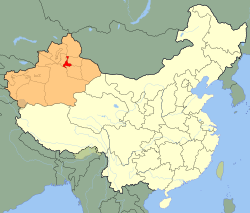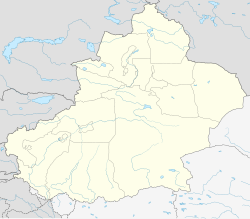Urumuqi
|
Ürümqi 乌鲁木齐市 • ئۈرۈمچى شەھىرى |
|
|---|---|
| Prefecture-level city | |

|
|
 Ürümqi (red) in Xinjiang (orange) |
|
| Location of the city centre in Xinjiang | |
| Coordinates: 43°49′30″N 87°36′00″E / 43.82500°N 87.60000°ECoordinates: 43°49′30″N 87°36′00″E / 43.82500°N 87.60000°E | |
| Country |
|
| Region | Xinjiang |
| County-level divisions | 8 |
| Government | |
| • CPC Committee Secretary | Li Xuejun |
| • Mayor | Ilham Sabir |
| Area | |
| • Total | 14,577 km2 (5,628 sq mi) |
| Population (2010 census) | |
| • Total | 3,112,559 |
| • Estimate (2015) | 3,550,000 |
| • Density | 210/km2 (550/sq mi) |
| Time zone |
De jure: China Standard (UTC+8) De facto: both China Standard (UTC+8) and Ürümqi Time (UTC+6) |
| Postal code | 830000 |
| Area code(s) | 991 |
| License plate prefixes | 新A |
| GDP (2013) |
CNY 240 billion US $38.63 billion |
| GDP per capita |
CNY 68,691 US $11,057 |
| ISO 3166-2 | CN-65-01 |
| Website | www.urumqi.gov.cn (Chinese) |
| Ürümqi | |||||||||||||||

"Ürümqi" in Simplified Chinese (top), Traditional Chinese (middle), and Uighur Arabic (bottom) characters
|
|||||||||||||||
| Chinese name | |||||||||||||||
|---|---|---|---|---|---|---|---|---|---|---|---|---|---|---|---|
| Simplified Chinese | 乌鲁木齐 | ||||||||||||||
| Traditional Chinese | 烏魯木齊 | ||||||||||||||
| Postal | Urumtsi | ||||||||||||||
| Literal meaning | "beautiful pasture" (in Oirat) | ||||||||||||||
|
|||||||||||||||
| Dihua | |||||||||||||||
| Chinese | 迪化 | ||||||||||||||
| Postal | Tihwa | ||||||||||||||
| Literal meaning | "to enlighten" | ||||||||||||||
|
|||||||||||||||
| Mongolian name | |||||||||||||||
| Mongolian Cyrillic | Өрөмч | ||||||||||||||
| Mongolian script | ᠥᠷᠥᠮᠴᠢ | ||||||||||||||
| Uyghur name | |||||||||||||||
| Uyghur |
ئۈرۈمچى
|
||||||||||||||
|
|||||||||||||||
| Transcriptions | |
|---|---|
| Standard Mandarin | |
| Hanyu Pinyin | Wūlǔmùqí |
| Wade–Giles | Wu1-lu3-mu4-ch'i2 |
| IPA | [úlùmûtɕʰǐ] |
| Yue: Cantonese | |
| Jyutping | wu1lou5muk6cai4 |
| Transcriptions | |
|---|---|
| Standard Mandarin | |
| Hanyu Pinyin | Dǐhuà |
| Wade–Giles | Ti3-hua4 |
| IPA | [tìxwâ] |
| Transcriptions | |
|---|---|
| Latin Yëziqi | Ürümchi |
| Yengi Yeziⱪ | Ürümqi |
| SASM/GNC | Ürümqi |
| Siril Yëziqi | Үрүмчи |
| Uyghur IPA | pronounced [ʏrʏmˈtʃi] |
Ürümqi (Chinese: 乌鲁木齐; pinyin: Wūlǔmùqí, Uyghur: ئۈرۈمچى; from Oirat "beautiful pasture") is the capital of the Xinjiang Uyghur Autonomous Region of the People's Republic of China in Northwest China. Ürümqi was a major hub on the Silk Road during China's Tang dynasty, and developed its reputation as a leading cultural and commercial center during Qing dynasty in 19th Century.
With an estimated population of 3.5 million in 2015, Ürümqi is the largest city in China's western interior as well as in Central Asia in terms of the population. Ürümqi has seen a huge economical development since the 1990s and currently serves as a regional transport node, a cultural, political and commercial center.
Although Ürümqi is situated near the northern route of the Silk Road, the present city is a relatively young city. It was not called Urumqi until the time of the Dzungar Khanate. An older settlement named Luntai was located nearby, around 10 kilometres (6 miles) from the southern suburb of present-day Ürümqi. Luntai was set up by the Tang government during the 22nd year of Emperor Taizong's reign (648 AD) in the ancient town seat of Urabo as part of the Protectorate General to Pacify the West that controlled Xinjiang. It was a seat of local government, and collected taxes from the caravans along the northern route of the Silk Road. After the Tang retreated from the Western Regions, the region came under the control of the Uyghurs of the Khaganate and Gaochang/Qocho. From Tang to Qing Dynasty, there was little information about the Ürümqi area, and there appeared to be no permanent settlement here for most of this period. The Mongols referred to the wider area as Bishbalik meaning five cities, referring to the five towns that surrounded the present-day Ürümqi area.
...
Wikipedia

